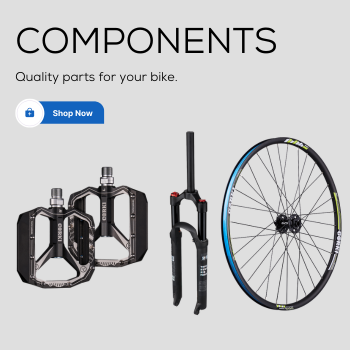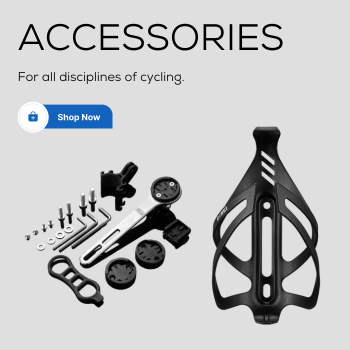
What's the Difference Between MTB Handlebars?
The handlebars are the contact point between you and your mountain bike. So choosing the right ones can make a big difference in your riding adventure. But with so many different handlebars on the market, how do you know which one is right for you? Ultimately, trying different designs and styles is the best way to find the best handlebar for you. It's not easy, so here are some key factors to remember when looking for a new handlebar.
Types of MTB Handlebars
Riser bars and flat bars are two of the most common types of MTB handlebars. Each one has its unique features and benefits.
Riser bars, or "rise bars," are handlebars with a rise or upward sweep at the center. The difference between a 30mm and 50mm riser bar is the amount of rise or upward sweep. A 50mm riser bar will have a higher center point than a 30mm riser bar, which can affect the rider's posture and handling of the bike. A higher-rise bar gives a more upright riding position and better control in tricky terrain, while a lower-rise bar is more aerodynamic and better for high speeds. It's up to your preference and riding style to choose between a 30mm or 50mm rise bar.
Flat bars refer to handlebars with a straight and flat design without any rise or curve. These handlebars are popular among riders who prefer a more upright riding position and better control over their bike. In addition, flat bars are often wider than other types of handlebars, which can provide more stability and power when riding over rough terrain. As for the cross-country riders who want a more aerodynamic position., they are more likely to choose narrower bars.

When choosing between riser bars and flat bars, it's necessary to consider your personal riding style and preferences. For example, flat bars may be the best choice if you mainly ride cross-country trails or want a lightweight and maneuverable handlebar. On the other hand, riser bars may be your type if you primarily ride downhill or want more control and stability on technical terrain.
Width
The width of your MTB handlebars can significantly impact your comfort, control, and performance. If your handlebars are too narrow, you may feel overcrowded and unstable. If your handlebars are too wide, you may feel uncomfortable and have difficulty maneuvering your bike. To measure the correct handlebar width for your MTB, you'll need to measure the distance between your shoulder blades and add 2-4cm to that measurement. This will give you the ideal handlebar width for your body type. According to the width of the handlebars, we have a rough classification.

Narrow handlebars
Narrow handlebars are typically between 680mm to 720mm wide. They offer more precise handling and are ideal for cross-country riding, where speed and efficiency are important.
Medium handlebars
Medium handlebars are usually between 720mm to 780mm wide. They balance control and stability, making them suitable for trail riding.
Wide handlebars
Wide handlebars are usually between 780mm to 820mm wide. They offer the best stability and control, making them ideal for downhill and aggressive riding.
A wider handlebar can provide stability and control, benefiting technical terrain and downhill riding. A wider handlebar can also help distribute your weight more evenly, reducing fatigue and discomfort on long rides. However, a wider handlebar can also make it more challenging to maneuver your bike in tight spaces, which can be a disadvantage for cross-country riding.
A narrower handlebar can provide more agility and speed, benefiting cross-country riding and technical climbs. A narrower handlebar can also make maneuvering your bike in tight spaces more manageable, which can be an advantage for technical terrain. However, a narrower handlebar can also feel cramped and unstable, which can be disadvantage for downhill riding.
Rise and Sweep
The handlebar rise and sweep determine the shape of your handlebars. There are many different handlebar options with varying rise and sweep configurations. The rise is the vertical distance from the center of the bar to the bar end and can range from 0mm to over 40mm. A higher rise can benefit riders on steep terrain as it shifts weight to the back of the bike. Conversely, a lower rise can help keep weight over the front of the bike for steep climbs.

Flat handlebars
Flat handlebars have no rise and are parallel to the ground. They are typically found on cross-country and endurance mountain bikes. Flat handlebars offer a low and aerodynamic riding position, which is ideal for speed and efficiency.
Low-rise handlebars
Low-rise handlebars have a slight rise, usually ranging from 5mm to 30mm. We typically use them on trail and all-mountain bikes. Low-rise handlebars provide a more upright riding position compared to flat handlebars, which can improve comfort and control.
Mid-rise handlebars
Mid-rise handlebars have a higher rise than low-rise handlebars, usually ranging from 30mm to 50mm. They are suitable for aggressive trail riding and all-mountain riding, offering a more upright position and better control.
High-rise handlebars
High-rise handlebars have a higher rise, typically exceeding 50mm. They are always used on downhill bikes and provide a very upright riding position. Allowing the rider to shift their weight and control the bike easily.
Sweep refers to the bend of the handlebar and is divided into up sweep and back sweep. Up sweep is the angle from the clamping surface to the handlebar, while back sweep is the angle from the clamping surface back to the handlebar. Mountain bike handlebars usually have around 5° up sweep and 7-10° back sweep. The choice of sweep is a matter of personal comfort, as it affects the positioning of the upper body. It's essential to find what works for you and consider your current handlebar when upgrading.
Clamp Diameter
In recent years, there has been a trend in the industry towards using 35mm clamp diameter handlebars and stems instead of the traditional 31.8mm seatpost clamp. Each standard has its advantages and disadvantages. The stem is the component that connects the handlebars to the fork steerer tube and the bike frame. The stem is responsible for holding the handlebars securely in place and allowing the rider to steer the bike. Different types of stems have different clamping diameters, which can affect the compatibility of different handlebars.

The clamp diameter refers to the diameter of the part of the stem that clamps onto the handlebars. Standard clamp diameters for MTB handlebars include 31.8mm and 35mm. Choosing a set of handlebars with a clamp diameter that matches your current stem is essential. If your current stem has a different clamp diameter from your new handlebars, you will need to replace your stem as well. Remember to choose a combination that provides the right fit and handling for your body type and riding style.
Material
MTB handlebars can be made from various materials, each with its unique characteristics and benefits. However, the three most common materials for MTB handlebars are aluminum, carbon fiber, and titanium.
Aluminum is the most common material used for MTB handlebars. It is known for its strength, durability, and affordability. Aluminum handlebars are an ideal choice among riders who want a reliable and affordable option that can withstand the rigors of off-road riding. Aluminum handlebars are also relatively lightweight, making them great for riders who want to reduce the overall weight of their bike. However, aluminum can be prone to fatigue over time, especially if it is subjected to repeated stress or impact.

Carbon fiber handlebars are available for riders who want a lighter weight and more responsive feel. Carbon fiber is a strong and lightweight material known for its stiffness and durability. Carbon fiber handlebars can help reduce the overall weight of your bike, which can be beneficial for speed and efficiency. Carbon fiber handlebars are also known for their shock-absorbing properties, which can provide a more comfortable ride on rough terrain. However, carbon fiber handlebars can be more expensive than other materials and may need to be more durable in case of a crash or impact.

Titanium handlebars are less used than aluminum and carbon fiber but offer a good balance of strength, weight, and flexibility. Titanium is a strong and lightweight material known for its durability and resistance to corrosion. Also, it can provide a more comfortable ride on rough terrain. As a result, titanium handlebars can be a good choice for riders who want a high-quality and reliable option that can withstand the rigors of off-road riding. Well, titanium may be an excellent choice for a handlebar, but unfortunately, it costs a pretty penny.

Why Are MTB Handlebars So Wide?
Mountain bikes are built with a very specific purpose in mind: to traverse rugged terrain with quickness and agility. When descending a rocky trail, maintaining control is crucial for the rider's safety, and this is where wider handlebars come into play. However, the reasons for using wider handlebars on mountain bikes are not just about safety; they are also deeply technical. In this part, we will explore each of these reasons in detail, so please read on.
Better Control
Wider handlebars give riders more leverage and control over their bike, especially on technical terrain. Mountain biking often involves riding over rough, unpredictable terrain, so having a wider handlebar can help riders maintain control and stability. With wider handlebars, riders can use their body weight to steer the bike, which can be especially helpful when navigating tight turns or steep descents. Additionally, wider handlebars can help riders feel more confident and in control, which can make for a more enjoyable ride.
Improved Stability
A wider handlebar can help improve a rider's balance and stability, especially at higher speeds or when riding over rough terrain. When riding on uneven terrain, a wider handlebar can help absorb some of the impacts, making for a smoother ride. Additionally, a wider handlebar can help distribute a rider's weight more evenly across the bike, which can help improve stability and balance. This can be especially helpful when riding downhill or over technical obstacles.
Comfort
A wider handlebar can provide a more comfortable riding position, especially for riders with broader shoulders. With a wider handlebar, riders can achieve a more natural riding position that puts less strain on their shoulders and upper body. This can help reduce fatigue and discomfort on longer rides. Additionally, a wider handlebar can help improve breathing by allowing riders to open up their chest more fully.
Increased Power
Wider handlebars can help riders generate more power and speed, especially when climbing steep hills or navigating technical sections. With a wider handlebar, riders can use their upper body strength to help power the bike forward. This can be especially helpful when climbing steep hills or when riding over technical terrain that requires quick bursts of power. Additionally, a wider handlebar can help improve pedaling efficiency by allowing riders to get into a more comfortable position that puts less strain on their lower back and hips.
Better Aerodynamics
While not as important for mountain biking as it is for road cycling, a wider handlebar can still offer some aerodynamic benefits by allowing riders to get into a lower, more streamlined position. By lowering their body position, riders can reduce wind resistance and improve their overall speed. This can be especially helpful when riding on flat or slightly downhill sections of the trail. Additionally, a wider handlebar can help improve overall bike stability by providing a wider base of support for the rider's upper body.
How Wide Should MTB Handlebars Be?
Each cyclist has unique characteristics. Thus, there is no universal formula to determine the ideal handlebar. The type of handlebars is subjective and primarily influenced by personal preference and body type. However, here are some general recommendations:
For downhill riding, a handlebar with a 35mm clamp diameter and a width of 780mm or 800mm is a good choice for strength and stability. A higher upsweep angle, such as 30 degrees or more, can also help with wrist comfort and control during steep descents.
For dirt jumping, it's recommended to choose a handlebar with a width between 720mm and 800mm, depending on your personal preference. A handlebar with a 35mm clamp diameter is also a good option for added strength and stability. As for the rise, we suggested using a handlebar with a low rise of 10mm to 30mm for better maneuverability in the air.
Modern trail/Enduro mountain bikes typically sport a 20-25 millimeter rise bar. In addition, Enduro riders often opt for wider handlebars, up to 820mm, to provide greater leverage and control on technical terrain, while still maintaining good maneuverability.
These days, cross-country handlebars typically start around 700mm wide and rise to around 780mm. Of course, you might prefer a 10-millimeter rise or even a flat bar if you're a cross-country rider.

Conclusion
Picking the perfect handlebars for your mountain bike can mean the difference between a smooth ride and feeling like you're riding a bucking bronco. So choose wisely and test a bunch of options! Here riding friends or families bikes is a cheaper option.
Whether you're a beginner or an experienced rider, invest in a high-quality handlebar. This is a smart choice that can help you get the most out of your MTB and push your own riding progression.
To your next ride.




